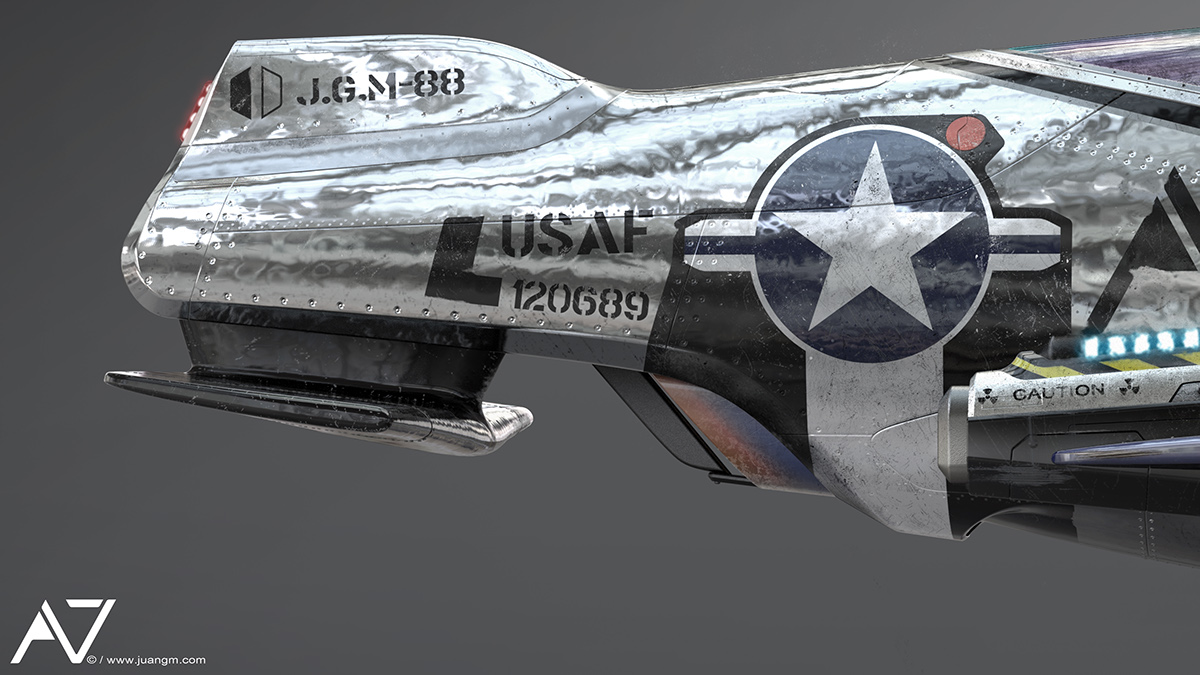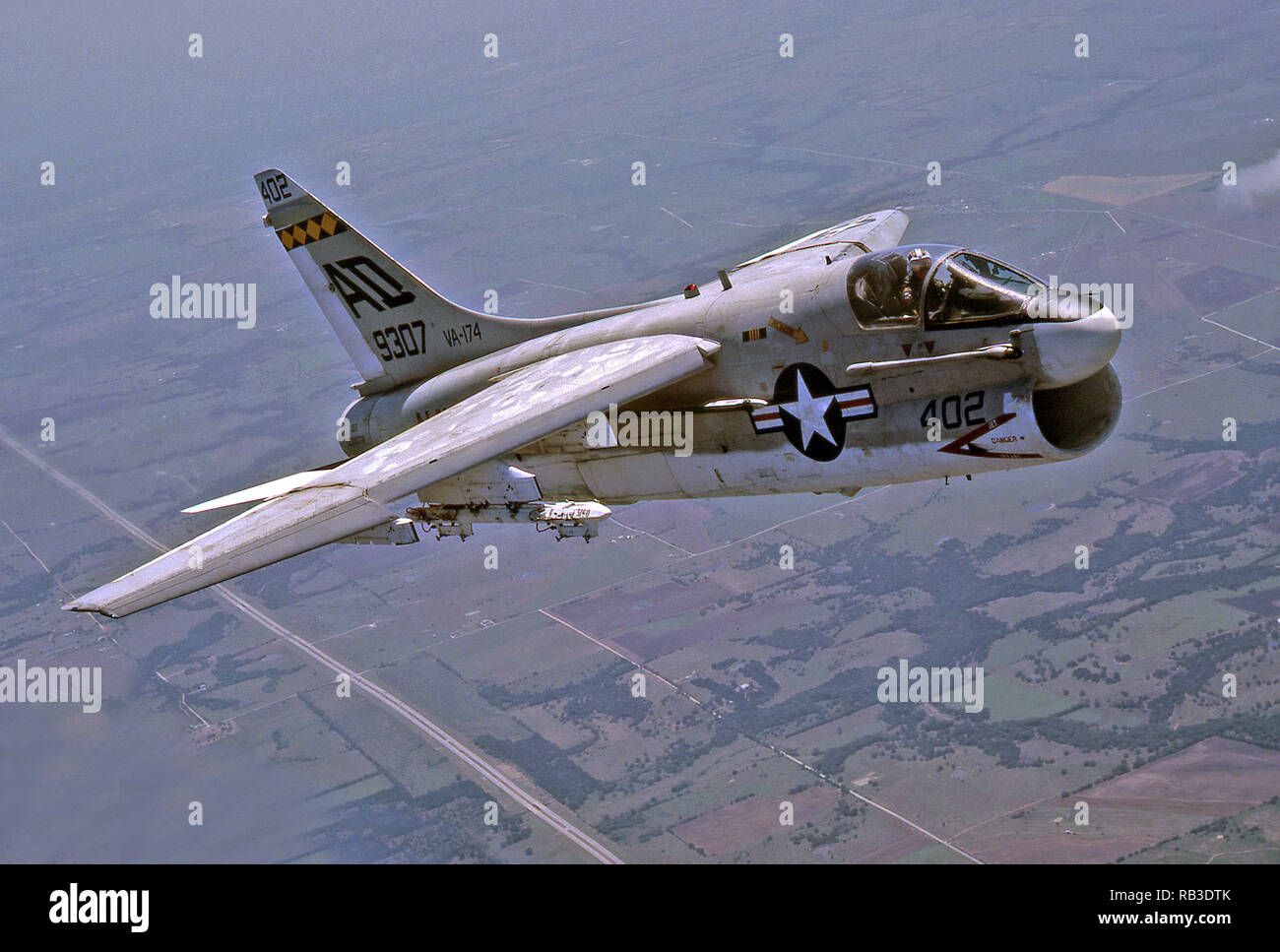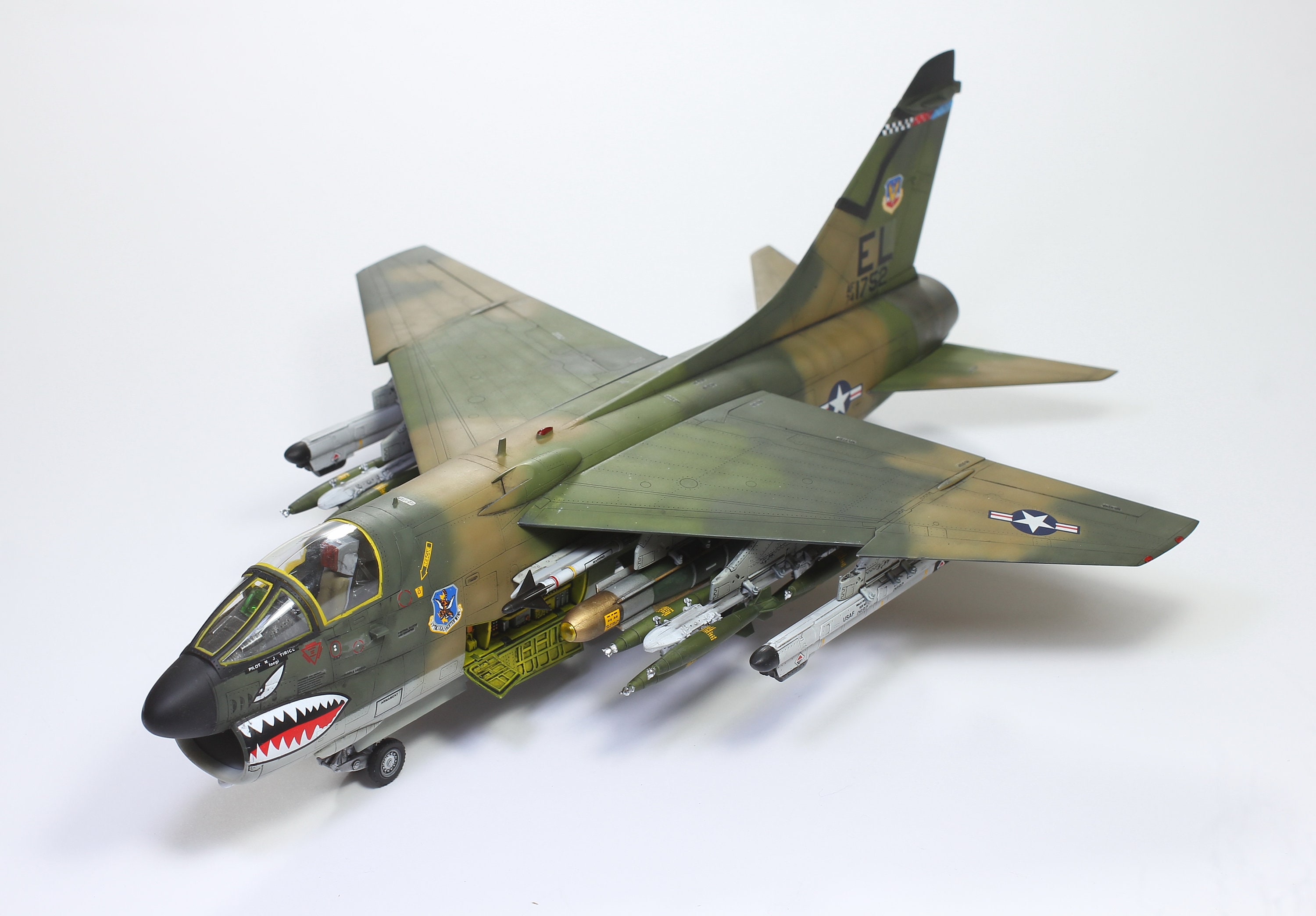A7 Fighter Jet - The LTV A-7 Corsair II is a US aircraft carrier-capable subsonic light attack aircraft designed and built by Ling-Temco-Vought (LTV).
The A-7 was developed in the early 1960s to replace the Douglas A-4 Skyhawk. Its design is derived from the Vought F-8 Crusader. Compared to the F-8, the A-7 is smaller and has limited subsonic speeds, its airframe is simpler and cheaper to build. Following a competitive bid by Vought in response to US Navy (USN) VAL requirements (heavier than air, light attack), the first contract for this class was issued on 8 February 1964. Developmt was flexible, first flew time on 26 Sep 1965 and Squadron service with USN on 1 Feb 1967. That year, the A-7 deployed overseas for the Vietnam War.
A7 Fighter Jet

Originally adopted by the USN, the A-7 proved attractive to other services, soon to be adopted by the US Air Force (USAF) and National Guard (ANG) to replace the Douglas A-1 Skyraider and its F-100 of North America. Super Saber Fleet. The upgraded A-7 will be designed to typically use more powerful genes and increase the aircraft's capabilities. American A-7s would be used in many major conflicts, including the invasion of Grada, Operation El Dorado Canyon, and the Gulf War. This type was also used to support the development of the Lockheed F-117 Nighthawk.
K, 5k, 6k, A 7a Corsair 2, Airplane, Painting Art
A-7s were also exported to Greece in the 1970s and Portugal in the late 1980s. The USAF and USN chose to retire their remaining models in 1991, followed by the ANG in 1993 and the Portuguese Air Force in 1999. .The A-7 has been replaced by next-generation fighter jets such as the General Dynamics F-16 Fighting. Falcon and McDonnell Douglas F / A-18 Hornet. The last carrier, the Hellenic Air Force, retired the last A-7 in 2014.
In 1960, United States Navy (USN) officers began considering the need to replace the existing Douglas A-4 Skyhawk fleet with light attack aircraft.
At the time, it was unclear whether the A-4 would remain in production until 1979. Additionally, according to aviation writers Bill Gunston and Peter Gilchrist, some figures believe there is an elusive need for a more capable attack platform that can regularly reach supersonic speeds, carry heavier loads and fly. Much more than its predecessor. Supporters of the new attack include Defense Secretary Robert McNamara, who urged the Navy to look into the matter.
In December 1962, the Surveillance Force Study Group (SBASF) began a detailed review and evaluation of the subject.
Razbam A 7 Corsair Ii Tacpack Edition, Razbam Quality Aircraft For Flight Simulation
The team analyzed a total of 144 hypothetical aircraft to support their findings. According to Gunston and Gilchrist, one of the key findings from these studies is that subsonic airplanes will achieve better performance than a supersonic one.
Considering the previous supersonic capacity, airframes can be smaller, cheaper and easier to manufacture. Significant quantities of such attack platforms can be purchased in supersonic counterparts. Deployment speeds are also increased by sticking to subsonic speeds, which is an added bonus.
Particular emphasis is placed on providing the appropriate weapons that will reduce the cost of ammunition per target.

On 17 May 1963, these criteria were developed into a draft requirement known as VAL (Heavier than Wind, Light Attack).
Cecil Field Pow/mia Memorial
The Vought proposal is based on the successful F-8 Crusader fighter and shares a similar configuration. However, it has a shorter airframe with a rounded nose, which gives the aircraft a "stubborn" look.
All bids were received in September 1963 and the evaluation process was completed in early November of that year.
On February 8, 1964, funding for VAL was approved by Congress, allowing the program to continue. Three days later, Vought's submission was selected as the winner.
On March 19, 1964, Vought was awarded a contract by the Navy to produce the first A-7 aircraft.
A7 Corsair Jet Fighter Aboard The Uss Midway In San Diego, California Stock Photo
In 1965 the A-7 received the title Corsair II. Vought once produced three aircraft known as the "Corsair". During the 1920s, they produced the O2U Corsair biplane reconnaissance aircraft and the 1930s SBU Corsair bomber. During World War II, the company successfully developed the F4U Corsair. The name Corsair II reflects the famous F4U Corsair, which served as a capable bomber in World War II and the Korean War. It is supposed to breed between aircraft from the same manufacturer and intended for the same ground attack role.
On November 2, 1965, Vought publicly unveiled the first pair of A-7As to 1,000 visitors. Test pilot John Conrad demonstrated the aircraft's ability to maneuver quickly, with six guys weighing 250 pounds (110 kg) and 12,500 pounds (230 kg) of bombs. A Navy spokesman acknowledged the A-7's ability to carry twice as many bombs as the A-4E, or the same load over twice the maximum distance.
The flight test program was operated at a high speed during which no significant delays were detected or significant delays were experienced. According to Gunston and Gilchrist, there were some Navy officials who tried to downgrade the program so that the A-7 aircraft system would be modified for greater capabilities, but that preference was overruled by the rush to accept this type of service.

On October 14, 1966, ough aircraft were delivered to the Navy, where the first group could be formed.
San Diego, California
The first A-7 Squadron received operational status on 1 February 1967. These could begin overseas combat operations during the escalating Vietnam War in December of that year.
The renewal contract, signed in September 1965, ordered an additional 140 aircraft. A third contract for 17 aircraft resulted in the production of a total of 199 A-7As.
As the initial version was found to be more powerful, a larger order was placed for 196 refurbished A-7B aircraft equipped with the more powerful Pratt & Whitney TF30-8 engine. . Other variant types would be ordered, including the A-7D for the United States Air Force (USAF) in 1966.
Partly due to lack of genes, the Allison TF41-A-2, a licensed derivative of Rolls-Royce Spey genes, is powered by an A-7D engine.
Fsx A7 Corsair Ii Static Scenery Object
During 1967, the Navy decided to cancel its orders for the A-7B, resulting in 257 fewer aircraft being built.
Instead, the A-7E, a specific aircraft model, was confirmed and put into production. This variant incorporates several upgrades of the USAF A-7D, including the TF41 engine and many of its avionics. However, the Gin was modified for further thrust and the linkage modified for compatibility with naval systems.
On November 25, 1968, the first A-7E made its maiden flight. A total of 535 aircraft of this type will be produced.

During the 1970s and 1980s, specialized models such as the TA-7C for training and the EA-7L for electronic warfare were also developed.
Jiestar A 7 Attack Aircraft
The LTV A-7 Corsair II is a subsonic fighter aircraft capable of carrying. It is a derivative of the Vought F-8 Crusader, a former fighter. Compared to the Crusader, it has a smaller, wider hull and longer wings, but lacks the Crusader's attack variables. The wings of the A-7 were not only longer, but also tapered back, as well as six pylons with a capacity of up to 15,000 lb (6,800 kg) of cargo or other equipment.
According to Gunston and Gilchirst, there are no common structural features shared between the two aircraft, although there are visual similarities and shared heritages.
However, external conventional flaps were used (instead of drooping flaps fitted inside the F-8's wing crease and doubling as flaps with the flaps deployed) along with large side-slotted flaps. The wing fold is between the spoon and the flight. The leading edge of the wing was solid and there was dog tooth wear.
A large airbrake is mounted on the underside of the aircraft. A three-module landing gear retracts into the fuselage. The twin-wheel nose device can be steered and strained for flight with the help of a guard.
Vought A 7 Corsair Ii
To achieve the required range, the first version of the A-7 was powered by a single Pratt & Whitney TF30-P-6 turbofan engine producing 11,350 lbf (50.5 kN).
The same vehicle also powered several other fighters of the era, including the Geral Dynamics F-111 Aardvark and the original Grumman F-14 Tomcat. The TF30-P-6 does not require a back burner for its role.
The next generation of the A-7 used different engines. According to Gunston and the Gilchrist, this was largely due to production difficulties in maintaining many military and civilian requirements.

These new powerplants include the more powerful Pratt & Whitney TF30-8 and Allison TF41-A-2 engines, a licensed version of Rolls-Royce Spey. TF41 corrects issues that originally affected the A-7's operation, such as severe compressor shutdown and low boost.
Buy Hasegawa A7 D/e Corsair Ii Usaf/navy Attacker Aircraft 1/48 Online At Lowest Price In Ubuy Bahrain. B003hc8ehe
The Air Force A-7D is self-propelled, starting with internal batteries and a gas turbine starter. The A-7E Navy used an air turbine starter with an external air supply.
Air is fed into the genie through a tube through a simple nozzle similar to the F-8, although it poses a serious hazard to the ship's crew.
Two cannons are mounted below
Ngad fighter jet, a7 fighter, f 15 fighter jet, latest us fighter jet, fighter jet toys, a7 jet fighter, a7 tornado fighter jet, fighter jet canvas, fighter jet party supplies, a7 jet, the newest fighter jet, fighter jet games
0 Comments